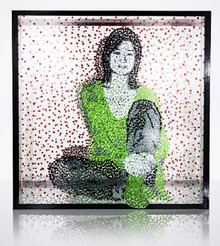Nationality Austrian Role Artist Name Norbert Brunner | Website www.norbertbrunner.com Known for object art | |
 | ||
Education | ||
Claire oliver gallery norbert brunner
Norbert Brunner (born 1969, Hohenems, Austria) is an Austrian object, conceptual and installation artist. Brunner’s mirror objects reflect not only the viewer, but also superimpose messages across their visual path, insisting they become an interactive part of the installation. He studied on the University of Applied Arts Vienna. Currently Brunner lives and works in Vienna and New York City.
Contents
Claire oliver gallery norbert brunner
Biography
Norbert Brunner was born in Hohenems, Vorarlberg Austria. After being raised in Vorarlberg he served a joinery apprenticeship and attended a vocational school for sculpture in Elbigenalp, Tyrol. He studied sculpting on the University of Applied Arts Vienna with professor Wander Bertoni. He also had been influenced by Oswald Oberhuber, Bernhard Leitner, Franz Graf and Isabelle Graw.
Brunner has public projects in Kobe, Japan; Edmonton, Canada and Birmington, UK. His work has been exhibited throughout the world including Beijing, China; Sydney, Australia; London, UK; Moscow, Russia; Berlin, Germany; Paris, France; Vienna, Graz, Austria; Geneva, Swiss; Prague, Czech; New York City, Dallas, USA; Osaka, Nagoya, Kyoto, Japan and Sydney, Australia. He also participated in the biennale in Valencia and the architecture biennale in Beijing, the expo Aichi in Nagoya and the Royal Academy of Art Summer Exhibition.
His works are part of important museum collections like the 21 Haus in Vienna, the New Britain Museum of American Art and the Vorarlberger Landesmuseum.
Work
Norbert Brunner's works are meant to inspire for the beholder to get a "broader" attitude of mind. In his objects he translates two dimensional images into a multi-dimensional design. His objects demand that the viewer examines them closely for full visual appreciation and understanding. This spatial interaction with the sculpture is forcing the viewer into a more extensive contention with the artwork. Brunner's mirror objects reflect not only the viewer, but also superimpose written messages. Using few but compelling words, Brunner’s texts reflect infinite possibilities asking us to formulate our own interpretation of reality.
Brunner employs acrylic glass, Swarovski crystal, mirror, photographic prints, paint, and foil in his creations that range in size from personal and intimate to monumental and communal. In his objects he defines the dot as the lowest common denominator. Everything consists of these dots, which are located next or above one another and make up the image. By putting foil dots on several layers of acrylic glass and mirrors he arranges layers in a sandwich system. When the viewer changes his position towards the object these images dissolve into many individual parts and reassemble only when seen from the right angle.
Brunner is always dreaming up new techniques and mediums to employ new means of "communication". As source material for his works, Brunner uses well-known objects or texts from everyday life which are universally familiar. They become his vocabulary of global communication with the aim to reach as many people as possible.
